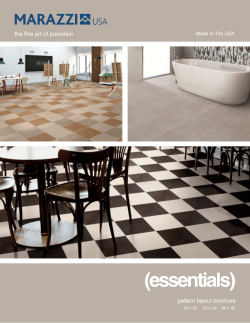
INSIDE TILE
HOPSCOTCH: 646 WINSLOW STREET FAYETTEVILLE, NC, 28306 PHONE (910) 485-2119 FAX (910) 484-4381 IT’S MORE THAN A KID’S GAME. INSIDE TILE INC AM ERICAN OLEAN SANDY RIDGE SY02 ALMOND SY03 LIGHT TAUPE Regularly: $2.72 SF On Sale Now: 89 cents SF* *WHILE SUPPLIES LAST* WE WILL BE CLOSED MONDAY SEPTEMBER 1ST, 2008 IN OBSERVANCE OF LABOR DAY. E-M AIL US YOUR QUESTIONS, ORDERS OR HELLOS! AUGUST 2008 Tiled floors look good. One way to make a good looking tiled floor look more extraordinary is by using a pattern. We have all seen tile installed straight, diagonal and on a running bond, but tile manufacturers today offer a wide range of sizes to do multiple size patterns. The following describes some different patterns as well as some things to keep in mind when installing a patterned floor. A fun and interesting two size pattern is a hopscotch pattern. You can use a 12x12 with an 18x18. You can use a 6x6 with a 12x12. You can use just about any two tile sizes you want to create that pattern. Another interesting pattern you see more in decorative listels or mosaic patterns is the pinwheel pattern. With more manufacturers producing modular strip or plank sizes, you can achieve the same look as the mosaics. For instance, you could use modular 12x12 tiles with modular 12x24 tiles to mimic that look. Floor patterns are not just limited to two sizes of tiles. There are Monson patterns, Versailles patterns, modified hopscotch patterns and many more that use at least three modular sizes that make floors look dynamic. Modular tiles are great for floor patterns for a couple reasons. For customers, it allows them the ability to have a patterned floor. For installers, modular tile sizes make an installation a little easier to work with. Modular tiles are produced to have grout joints that line up even with all the various size tiles in the pattern, ensuring consistent grout joints on a patterned floor. While floor patterns are a great idea to explore with your customers, shade and caliber are terms you need to think about when planning a floor pattern. Shade refers to the coloration of the tile. If you are working with two different colors in a pattern or with a tile with high shade variation, this is not as much of an issue as if you are working with a monotone pattern. With a one color pattern, it is important, if possible, to have all the same shade of tile in your pattern. This ensures an overall pleasing aesthetic appearance for the tile and pattern you are using on the floor. Caliber refers to the facial dimension (size) of a tile. If possible, it is very important to have the same caliber. Using different caliber sizes especially in a traditional black and white checkerboard pattern may result in a variation in grout joint widths among the pattern, and uneven grout lines are unsightly. When installing any pattern on the floor, be sure you lay out at least four interlocking tiles from the pattern. This helps you get a better visual for the floor as well as a better strategy for the actual installation. Lastly, it is best to get customer approval for the layout before you begin installation of a floor pattern. Winston Olive winstonolive@earthlink.net Renee Olive reneeolive@earthlink.net Woody Cox woodycox@earthlink.net Julie Machak juliemachak@earthlink.net Stacy Covington stacycovington@earthlink.net Susan Martin susanmartin321@earthlink.net HOPSCOTCH MODIFIED HOPSCOTCH PINWHEEL The shaded areas marked with letters indicate pattern repeat.
© Copyright 2025





















